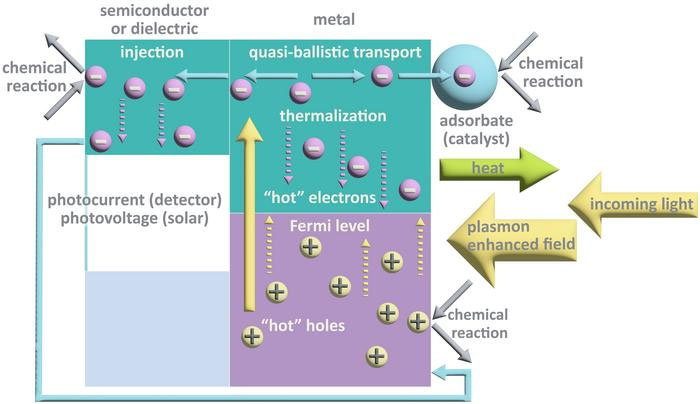| Aug 16, 2024 |
Unveiling the power of hot carriers in plasmonic nanostructures
(Nanowerk News) A new scientific review (eLight, "Hot-electron dynamics in plasmonic nanostructures: fundamentals, applications and overlooked aspects") explores the exciting potential of hot carriers, energetic electrons generated by light in plasmonic nanostructures. These tiny structures hold immense promise for future technologies due to their unique way of interacting with light and creating hot carriers.
|
|
Hot carriers are electrons with a surplus of energy. When light strikes a plasmonic nanostructure, it can excite these electrons, pushing them out of equilibrium. This non-equilibrium state unlocks a range of fascinating phenomena. Hot carriers can be used to control light itself, potentially leading to novel applications in light-based technologies. They can also drive chemical reactions at the surface of the nanostructure, paving the way for advanced photocatalysis. Also, hot carriers can generate electrical currents, opening doors for new ultrafast detectors and optoelectronic devices.
|
 |
| Schematics of hot-carrier processes in metal-semiconductor/dielectric heterostructures which interlinks photochemistry and nonlinear optics. (Image: Jacob Khurgin, Anton Yu. Bykov, Anatoly V. Zayats)
|
|
This research review illuminates the intricate details of hot carrier generation and behavior in plasmonic nanostructures. It explores how light interacts with these structures to create hot carriers, how hot carriers lose their energy and return to equilibrium, and methods to control hot carrier dynamics for specific applications.
|
|
By harnessing the power of hot carriers, scientists envision a future filled with innovative technologies. Hot carriers could enable ultrafast electronics and optoelectronics, boost the efficiency of solar cells, and even revolutionize nanomedicine through precise control. This research paves the way for further exploration and development of hot carrier technologies, bringing us closer to a future shaped by light and nanostructures.
|

